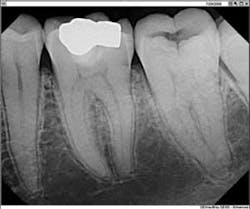X Files #2 — Green dental heroes save the environment daily
by Terry L. Myers, DDS, FAGD
For more on this topic, go to www.dentaleconomics.com and search using the following key words: digital radiography, going green, environmental responsibility, Dr. Terry Myers.
I still remember this public service commercial from the 1970s: a care-worn Native American paddles a canoe down a polluted river. He floats past smokestacks spewing noxious white smoke and reaches a littered riverbank. On the highway, someone tosses garbage from a car window. The camera focuses on the old man's face as his eyes fill with tears. A solemn narrator says, “Some people have a deep, abiding respect for the natural beauty that once was this country; some people don't.”
This scene has stayed with me over the years, and actually has made me more environmentally conscious. New technology is helping professionals take an active role in maintaining a cleaner, healthier world, as modern dental offices discover more options for “going green.”
• Dental offices are making environmental strides. One Oregon office recently was recognized as the first LEED (Leadership in Energy and Environmental Design) certified dental practice for its efforts. My office uses medical-grade hand sanitizer to save water, and hand towels for patients instead of paper towels. We also have installed energy-saving lightbulbs to cut down on heat and save energy. We established a “paperless” office by scanning all of our charts for new and established patients, and integrating those with our digital X-ray system.
• Digital radiography contributes to a safer environment. Dr. Cynthia Brattesani, from San Francisco, notes that digital technology is a powerful indicator of green consciousness at work in her practice. Her associates appreciate not having to clean the processor or change smelly developing chemicals that splash on their hands and uniforms. Many developing chemicals contain hazardous substances. Fixer and traditional X-ray film contain silver; processor cleaner can contain chromium; unused developer can contain hydroquinone; and traditional X-ray wrappers harbor lead. Dr. Brattesani adds that in her area, it is unlawful to spill these down the drain because they pollute the waterways. So, additional labor is needed to store traditional chemicals in appropriate containers, inspect them once a week for leaks, and dispose of them properly. A digital radiography system eliminates all of the extra work and mess, as well as the potential health concerns.
• An investment in a digital system makes financial sense. It's costly to maintain all the darkroom necessities and precautionary measures. Dr. Brattesani says, “I save money on developing supplies, hiring a company to haul away the hazardous waste, and on wasted time spent labeling and documenting the used chemicals, developing, or filing traditional film. Digital images are securely stored on my computer system, not taking up room in my filing cabinets.”
• Patients appreciate their dentist's dedication to the environment. Dr. Brattesani shares with her patients how digital technology helps the environment, and the assistants are instructed to always use the term “digital X-rays” when referring to imaging. Patients are so impressed with the new technology that they tell their friends.
I recently found some interesting statistics cited by the Eco Dentistry Association: “By converting to digital X-rays, a typical office can prevent disposal of at least 200 liters of toxic fixer and 17,200 lead foils in just five years.” And, “Digital patient charting saves as much as 10,000 sheets of paper a year in the typical dental practice.” We can make reasonable, environmentally responsible changes without hurting our budgets. We all have an obligation as professionals to take care of the environment. Going green is not just a marketing technique; it's our responsibility for a healthier future.
Dr. Terry Myers completed his residency in advanced general dentistry and served as an instructor in the Advanced Education in General Dentistry Residency Program, and director of the faculty practice at the University of Missouri-Kansas City School of Dentistry. He is a fellow in the Academy of General Dentistry, and a member of the Academy of Cosmetic Dentistry, as well as the Dental Sleep Disorder Society. Dr. Myers is on the board of directors at Research Belton Foundation and is a participating provider for the dental care program to improve children's dental care. His private practice is in Belton, Mo. Reach Dr. Myers by e-mail at [email protected].

